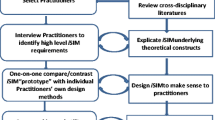Abstract
In recent times, globalization has brought us not only new opportunities but also new challenges. The theme of innovation has become a mandatory topic for all industries—it has become a focal point for the enterprise, society, and the world. The goal of innovation is to create business value by developing worthwhile ideas into a customer-centric marketable reality. This, for most companies, is difficult to achieve due to the lack of a methodology and tools for systematic innovative thinking. This article presents an operating system for innovation by offering a methodology for systematic innovative thinking and a toolbox of interconnected tools that can aid in the transformation of core product competencies into effective product–service amalgamations. Brief reviews of product innovation and emerging concepts of product–service systems are presented. Then, a methodology for systematic thinking is proposed, relying on the integration of the novel innovation matrix, application space mapping, and quality function deployment tools. Furthermore, a case study is presented with concluding remarks and future work.
Similar content being viewed by others
References
Group A (2010) Product innovation agenda: profiting from innovation today and tomorrow. Aberdeen Group, Boston, 2007
Allmendinger G, Lombreglia R (2006) Four strategies for the age of smart services. Harvard Business Review October:1–11
Bailey G, Wenzek H (2005) Irresistible! markets, models, and meta-value in consumer electronics. IBM, New Jersey
Baines TS et al (2007) State-of-the-art in product-service systems. Proc IMechE Part B: J Engineering Manufacture 221:1543–1552
Cohen L (1995) Quality function deployment: how to make QFD work for you. Addison-Wesley, Reading
Gaynor G (2002) Innovation by design. AMACOM, New York
Geibel M, Essman H, DuPreez N, Jochem R (2009) Improved innovation through the integration of quality gates into the enterprise and product lifecycle roadmaps. CIRP Journal of Manufacturing Science and Technology 199–205
Lee J (2003) Smart products and service systems for e-business transformation. Int J Technology Management 45–52
Lee J (2008) Dominant innovation design for product and service systems. PowerPoint Lecture Presentations, Sept–Dec. University of Cincinnati, Cincinnati
National Research Council of the National Academies (2001) Theoretical foundations for decision making in engineering design. The National Academies Press, Washington
National Research Council of the National Academies (2004) New directions in manufacturing: report of a workshop. The National Academies Press, Washington
Powel J, Moris F (2002) Different timelines for different technologies: evidence from the advanced technology program. National Institute of Standards and Technology (NIST) and US Department of Commerce, Gaithersburg
Oliva R, Kallenberg R (2003) Managing the transition from product to service. International Journal of Service Industry Management 160–172
Tang Z, Rongqiu C, Xuehong J (2005) An innovation process model for identifying manufacturing paradigms. International Journal of Production Research 2725–2742
Tien J, Berg D (2007) A calculus for services innovation. J Syst Sci Syst Eng 129–165
Uchihira N et al. (2008) Analysis and design methodology for recognizing opportunities and difficulties for product-based services. Journal of Information Processing 13–26
Author information
Authors and Affiliations
Corresponding author
Rights and permissions
About this article
Cite this article
Lee, J., AbuAli, M. Innovative Product Advanced Service Systems (I-PASS): methodology, tools, and applications for dominant service design. Int J Adv Manuf Technol 52, 1161–1173 (2011). https://doi.org/10.1007/s00170-010-2763-7
Received:
Accepted:
Published:
Issue Date:
DOI: https://doi.org/10.1007/s00170-010-2763-7




